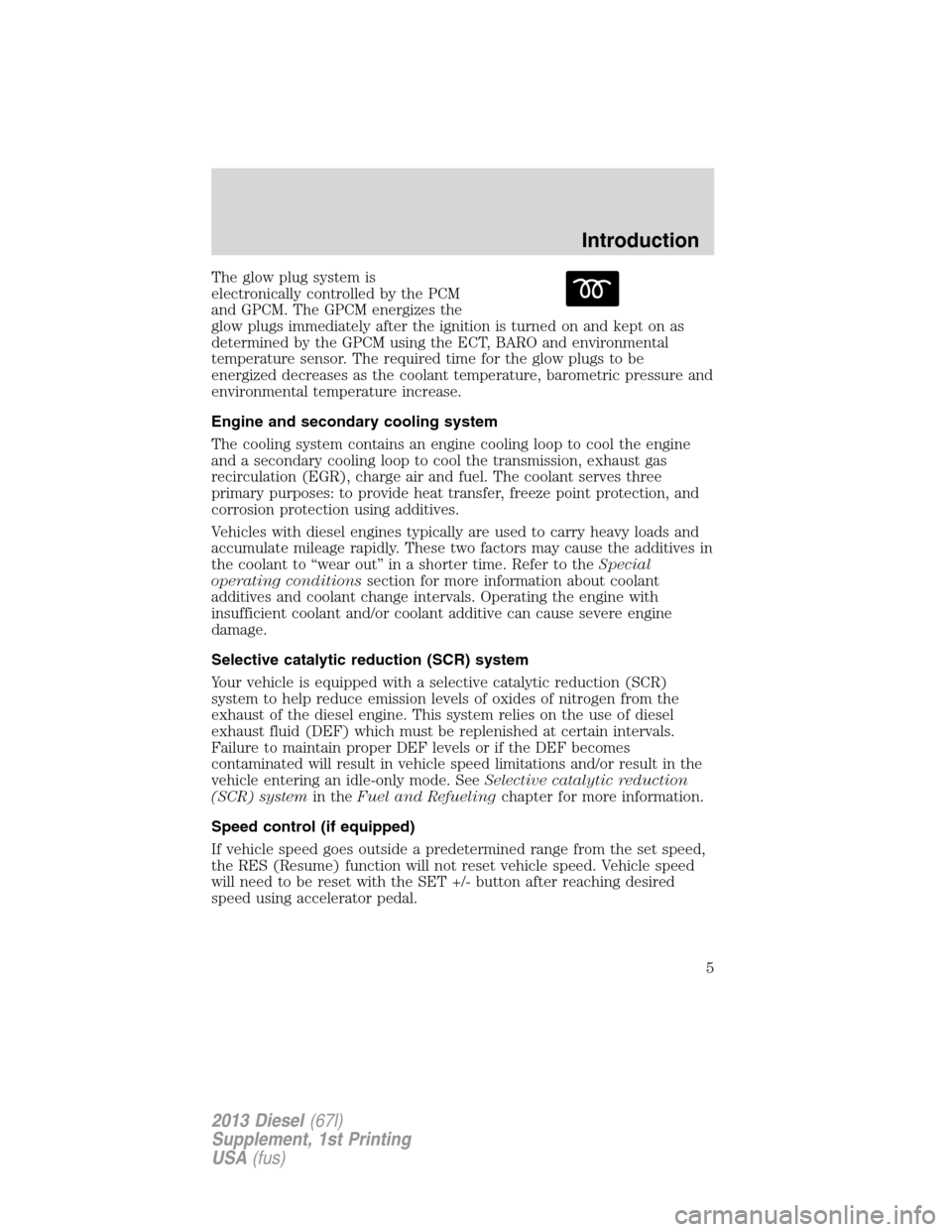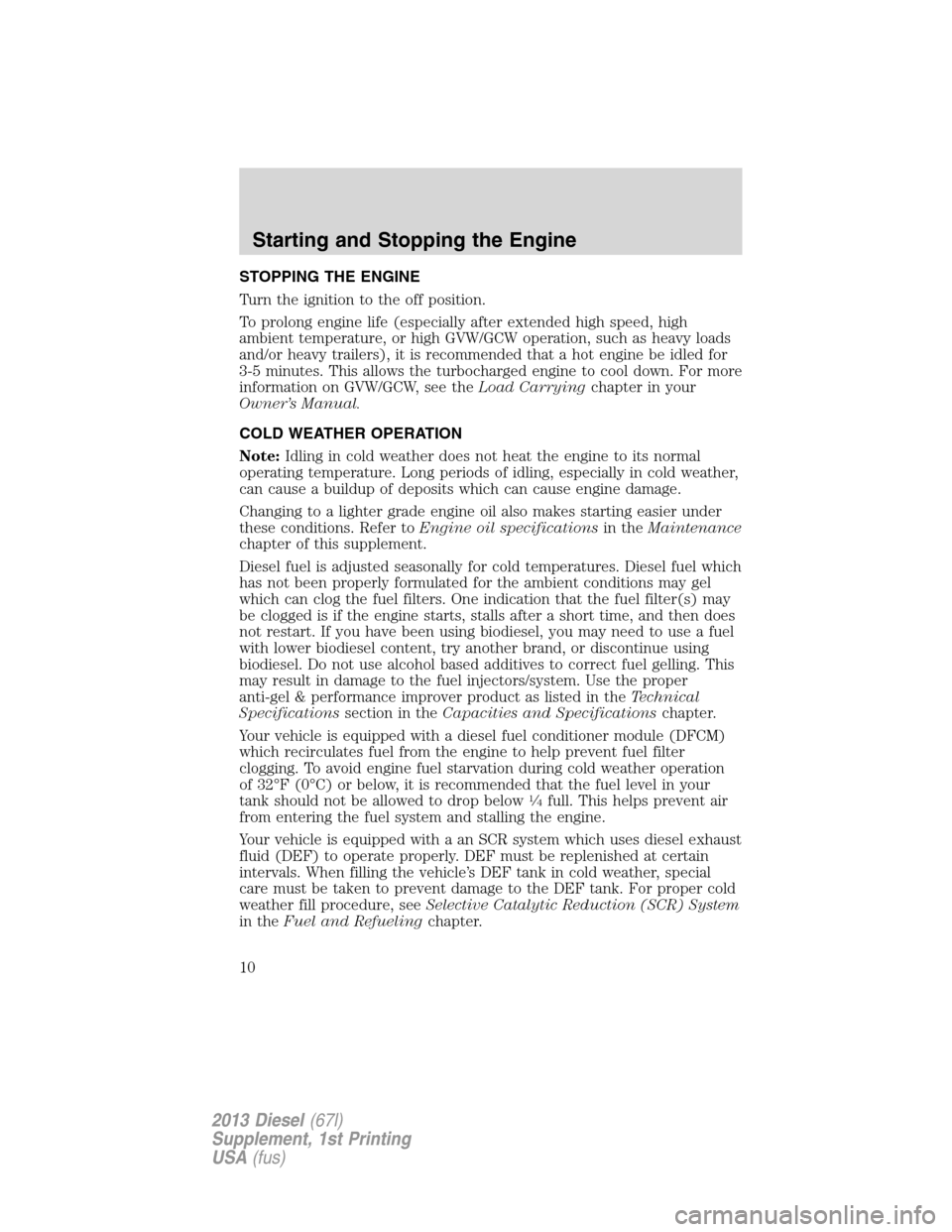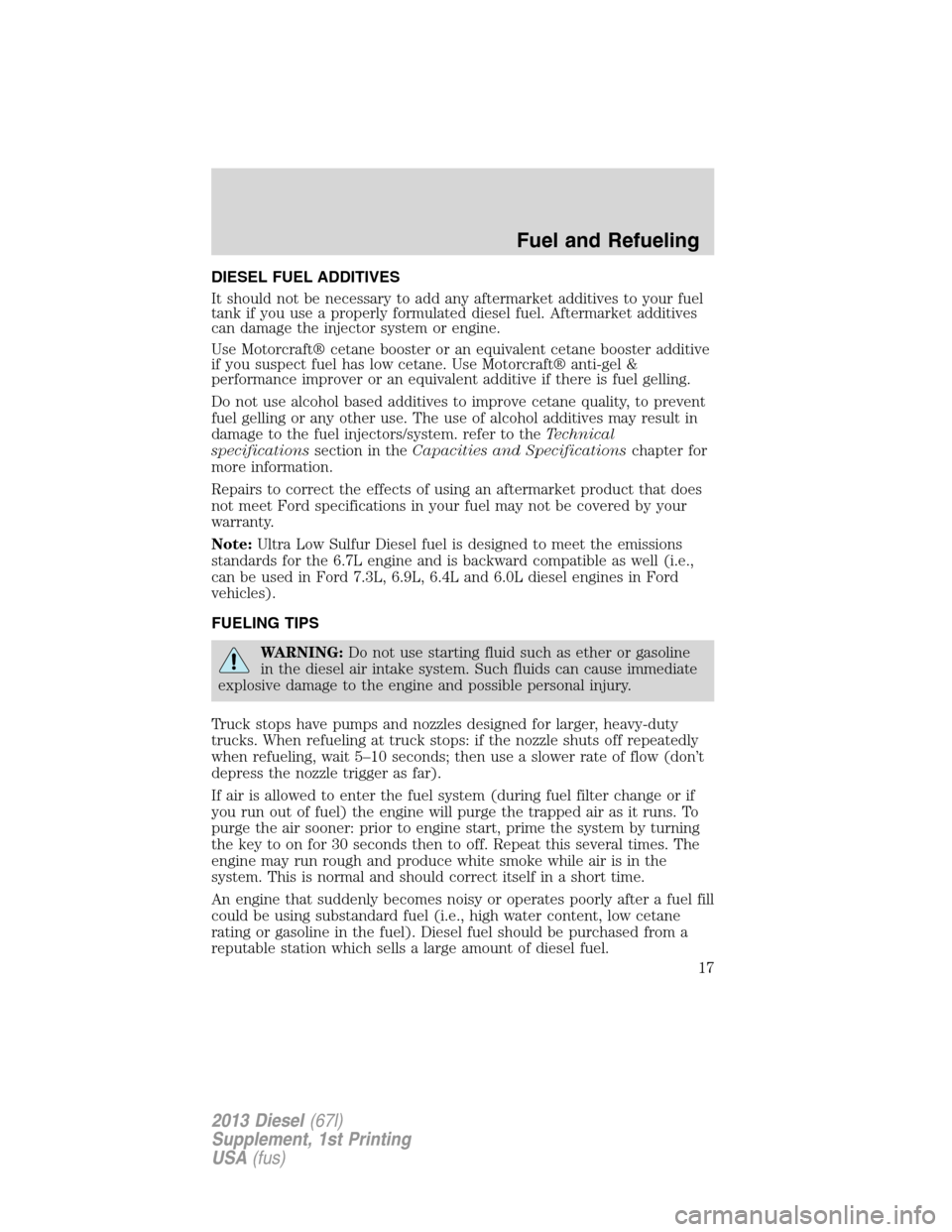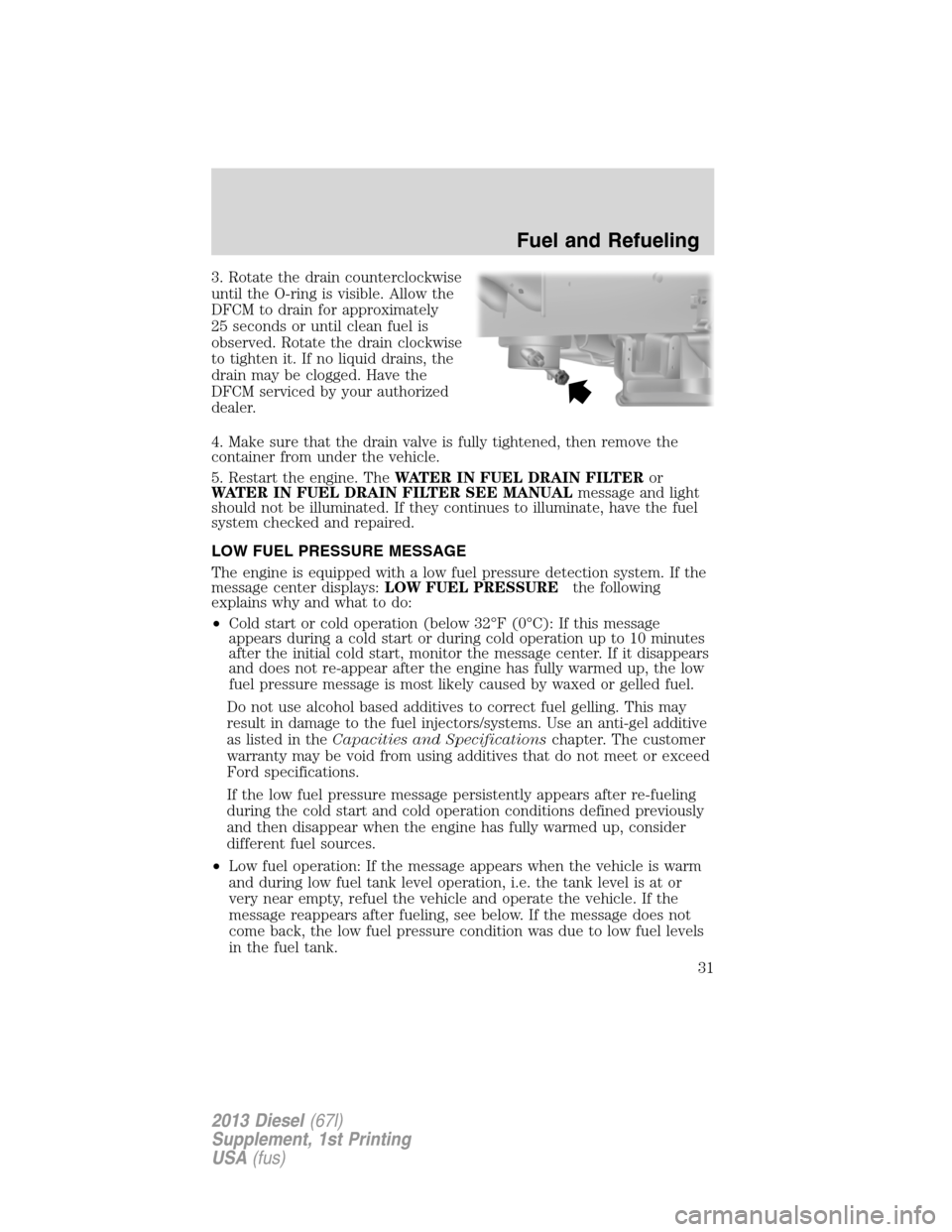2013 FORD SUPER DUTY fuel additives
[x] Cancel search: fuel additivesPage 4 of 95

BREAKING-IN YOUR VEHICLE
Your vehicle does not need an extensive break-in. Try not to drive
continuously at the same speed for the first 1,000 miles
(1,600 kilometers) of new vehicle operation. Vary your speed to allow
parts to adjust themselves to other parts.
Drive your new vehicle at least 500 miles (800 kilometers) before towing
a trailer. Make sure you use the specified engine oil by checking the
engine oil specification chart underEngine oilin theMaintenance
chapter.
Do not add friction modifier compounds or special break-in oils during
the first few thousand miles (kilometers) of operation, since these
additives may prevent piston ring seating. SeeEngine oilin the
Maintenancechapter of this supplement for more information on oil
usage.
DIESEL ENGINE INFORMATION
The diesel engine fuel system is a pressurized two-stage filtration system
and consists of:
•a frame-mounted diesel fuel conditioner module (DFCM) / primary
filter with an electric fuel pump and water drain,
•an engine-mounted secondary fuel filter,
•a fuel injector for each cylinder (8 total),
•a high-pressure fuel pump,
•a high-pressure fuel rail for each cylinder bank (2 total) and
•numerous high-pressure pipes from the high-pressure pump to the
rails, and rails to the injectors.
The DFCM acts as a primary fuel filter/water separator which removes
both water and impurities from the fuel. The engine mounted filter filters
finer impurities from the diesel fuel. The engine-mounted fuel filter and
the DFCM filter should be changed at the recommended service interval
or when indicated by the information displayLOW FUEL PRESSURE
message. Refer to thescheduled maintenance informationin this
supplement for more information.
The DFCM should be drained at regular intervals (recommended at
every oil change) or when indicated by the information display and water
in fuel indicator light. SeeFuel filter/water separatorin theFuel and
refuelingchapter.
Introduction
3
2013 Diesel(67l)
Supplement, 1st Printing
USA(fus)
Page 6 of 95

The glow plug system is
electronically controlled by the PCM
and GPCM. The GPCM energizes the
glow plugs immediately after the ignition is turned on and kept on as
determined by the GPCM using the ECT, BARO and environmental
temperature sensor. The required time for the glow plugs to be
energized decreases as the coolant temperature, barometric pressure and
environmental temperature increase.
Engine and secondary cooling system
The cooling system contains an engine cooling loop to cool the engine
and a secondary cooling loop to cool the transmission, exhaust gas
recirculation (EGR), charge air and fuel. The coolant serves three
primary purposes: to provide heat transfer, freeze point protection, and
corrosion protection using additives.
Vehicles with diesel engines typically are used to carry heavy loads and
accumulate mileage rapidly. These two factors may cause the additives in
the coolant to “wear out” in a shorter time. Refer to theSpecial
operating conditionssection for more information about coolant
additives and coolant change intervals. Operating the engine with
insufficient coolant and/or coolant additive can cause severe engine
damage.
Selective catalytic reduction (SCR) system
Your vehicle is equipped with a selective catalytic reduction (SCR)
system to help reduce emission levels of oxides of nitrogen from the
exhaust of the diesel engine. This system relies on the use of diesel
exhaust fluid (DEF) which must be replenished at certain intervals.
Failure to maintain proper DEF levels or if the DEF becomes
contaminated will result in vehicle speed limitations and/or result in the
vehicle entering an idle-only mode. SeeSelective catalytic reduction
(SCR) systemin theFuel and Refuelingchapter for more information.
Speed control (if equipped)
If vehicle speed goes outside a predetermined range from the set speed,
the RES (Resume) function will not reset vehicle speed. Vehicle speed
will need to be reset with the SET +/- button after reaching desired
speed using accelerator pedal.
Introduction
5
2013 Diesel(67l)
Supplement, 1st Printing
USA(fus)
Page 11 of 95

STOPPING THE ENGINE
Turn the ignition to the off position.
To prolong engine life (especially after extended high speed, high
ambient temperature, or high GVW/GCW operation, such as heavy loads
and/or heavy trailers), it is recommended that a hot engine be idled for
3-5 minutes. This allows the turbocharged engine to cool down. For more
information on GVW/GCW, see theLoad Carryingchapter in your
Owner’s Manual.
COLD WEATHER OPERATION
Note:Idling in cold weather does not heat the engine to its normal
operating temperature. Long periods of idling, especially in cold weather,
can cause a buildup of deposits which can cause engine damage.
Changing to a lighter grade engine oil also makes starting easier under
these conditions. Refer toEngine oil specificationsin theMaintenance
chapter of this supplement.
Diesel fuel is adjusted seasonally for cold temperatures. Diesel fuel which
has not been properly formulated for the ambient conditions may gel
which can clog the fuel filters. One indication that the fuel filter(s) may
be clogged is if the engine starts, stalls after a short time, and then does
not restart. If you have been using biodiesel, you may need to use a fuel
with lower biodiesel content, try another brand, or discontinue using
biodiesel. Do not use alcohol based additives to correct fuel gelling. This
may result in damage to the fuel injectors/system. Use the proper
anti-gel & performance improver product as listed in theTechnical
Specificationssection in theCapacities and Specificationschapter.
Your vehicle is equipped with a diesel fuel conditioner module (DFCM)
which recirculates fuel from the engine to help prevent fuel filter
clogging. To avoid engine fuel starvation during cold weather operation
of 32°F (0°C) or below, it is recommended that the fuel level in your
tank should not be allowed to drop below
1�4full. This helps prevent air
from entering the fuel system and stalling the engine.
Your vehicle is equipped with a an SCR system which uses diesel exhaust
fluid (DEF) to operate properly. DEF must be replenished at certain
intervals. When filling the vehicle’s DEF tank in cold weather, special
care must be taken to prevent damage to the DEF tank. For proper cold
weather fill procedure, seeSelective Catalytic Reduction (SCR) System
in theFuel and Refuelingchapter.
Starting and Stopping the Engine
10
2013 Diesel(67l)
Supplement, 1st Printing
USA(fus)
Page 18 of 95

DIESEL FUEL ADDITIVES
It should not be necessary to add any aftermarket additives to your fuel
tank if you use a properly formulated diesel fuel. Aftermarket additives
can damage the injector system or engine.
Use Motorcraft® cetane booster or an equivalent cetane booster additive
if you suspect fuel has low cetane. Use Motorcraft® anti-gel &
performance improver or an equivalent additive if there is fuel gelling.
Do not use alcohol based additives to improve cetane quality, to prevent
fuel gelling or any other use. The use of alcohol additives may result in
damage to the fuel injectors/system. refer to theTechnical
specificationssection in theCapacities and Specificationschapter for
more information.
Repairs to correct the effects of using an aftermarket product that does
not meet Ford specifications in your fuel may not be covered by your
warranty.
Note:Ultra Low Sulfur Diesel fuel is designed to meet the emissions
standards for the 6.7L engine and is backward compatible as well (i.e.,
can be used in Ford 7.3L, 6.9L, 6.4L and 6.0L diesel engines in Ford
vehicles).
FUELING TIPS
WARNING:Do not use starting fluid such as ether or gasoline
in the diesel air intake system. Such fluids can cause immediate
explosive damage to the engine and possible personal injury.
Truck stops have pumps and nozzles designed for larger, heavy-duty
trucks. When refueling at truck stops: if the nozzle shuts off repeatedly
when refueling, wait 5–10 seconds; then use a slower rate of flow (don’t
depress the nozzle trigger as far).
If air is allowed to enter the fuel system (during fuel filter change or if
you run out of fuel) the engine will purge the trapped air as it runs. To
purge the air sooner: prior to engine start, prime the system by turning
the key to on for 30 seconds then to off. Repeat this several times. The
engine may run rough and produce white smoke while air is in the
system. This is normal and should correct itself in a short time.
An engine that suddenly becomes noisy or operates poorly after a fuel fill
could be using substandard fuel (i.e., high water content, low cetane
rating or gasoline in the fuel). Diesel fuel should be purchased from a
reputable station which sells a large amount of diesel fuel.
Fuel and Refueling
17
2013 Diesel(67l)
Supplement, 1st Printing
USA(fus)
Page 32 of 95

3. Rotate the drain counterclockwise
until the O-ring is visible. Allow the
DFCM to drain for approximately
25 seconds or until clean fuel is
observed. Rotate the drain clockwise
to tighten it. If no liquid drains, the
drain may be clogged. Have the
DFCM serviced by your authorized
dealer.
4. Make sure that the drain valve is fully tightened, then remove the
container from under the vehicle.
5. Restart the engine. TheWATER IN FUEL DRAIN FILTERor
WATER IN FUEL DRAIN FILTER SEE MANUALmessage and light
should not be illuminated. If they continues to illuminate, have the fuel
system checked and repaired.
LOW FUEL PRESSURE MESSAGE
The engine is equipped with a low fuel pressure detection system. If the
message center displays:LOW FUEL PRESSUREthe following
explains why and what to do:
•Cold start or cold operation (below 32°F (0°C): If this message
appears during a cold start or during cold operation up to 10 minutes
after the initial cold start, monitor the message center. If it disappears
and does not re-appear after the engine has fully warmed up, the low
fuel pressure message is most likely caused by waxed or gelled fuel.
Do not use alcohol based additives to correct fuel gelling. This may
result in damage to the fuel injectors/systems. Use an anti-gel additive
as listed in theCapacities and Specificationschapter. The customer
warranty may be void from using additives that do not meet or exceed
Ford specifications.
If the low fuel pressure message persistently appears after re-fueling
during the cold start and cold operation conditions defined previously
and then disappear when the engine has fully warmed up, consider
different fuel sources.
•Low fuel operation: If the message appears when the vehicle is warm
and during low fuel tank level operation, i.e. the tank level is at or
very near empty, refuel the vehicle and operate the vehicle. If the
message reappears after fueling, see below. If the message does not
come back, the low fuel pressure condition was due to low fuel levels
in the fuel tank.
Fuel and Refueling
31
2013 Diesel(67l)
Supplement, 1st Printing
USA(fus)